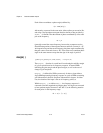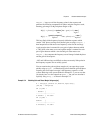
Chapter 5 Classical Feedback Analysis
Xmath Control Design Module 5-8 ni.com
because they can be used to assess the relative stability of a closed-loop
system given the frequency response of the open-loop system. It should be
noted that the open-loop system should be stable and minimum phase,
having no right-half plane poles or zeros, for this type of analysis [Oga70].
The following complex frequency response:
can be separated into two parts, which are both functions of the frequency:
• ω: the magnitude, A(ω)
• the phase, φ
The magnitude can be obtained as the absolute value of the response,
whereas the phase is obtained from the four-quadrant arctangent of the
response.
The standard Bode format comprises two subplots:
• The upper plot shows the decibel gain (the common logarithm of
the magnitude, multiplied by 20) plotted against the logarithm of the
frequency. Logarithmic (decibel) plots are a particularly useful tool
for indicating magnitude response because the multiplication of
magnitudes is shown as the sum of their logarithms, thus allowing
you to determine the system response with varying gains quickly.
• The lower plot shows the phase, in degrees, as a function of the
logarithm of the frequency. For both the gain and phase plots,
logarithmic frequency scaling is used because it allows a wide range
of frequency-dependent behavior to be displayed simultaneously.
Because the gain and phase plots are additive for systems cascaded in
series, Bode plots of an open-loop plant and potential compensators can be
added to determine the frequency-response characteristics of the complete
system. The plots also illustrate system bandwidth, as the frequency at
which the output magnitude is reduced by three decibels, or attenuated to
approximately 70.7% (a factor of of its original value.
Bode plots also provide an important aid to evaluate how stable—or,
more specifically, how close to instability—a closed-loop system is. As
discussed in the System Stability: Poles and Zeros section of Chapter 4,
System Analysis, for the continuous case, the closed-loop poles of a stable
system lie in the left half of the complex plane.
H ω() A ω()e
jφω()
=
22⁄()


















